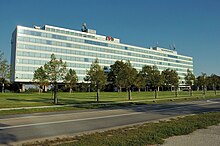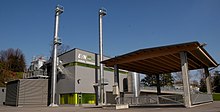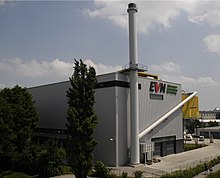EVN AG
| EVN AG
|
|
|---|---|
| legal form | Corporation |
| ISIN | AT0000741053 |
| founding | 1922 (as Niederösterreichische electricity-Aktiengesellschaft NEWAG; 1986 Newag-NIOGAS , then Power Low Austria EVN) |
| Seat | Maria Enzersdorf , Austria ⊙ |
| management |
|
| Number of employees | 7327 (2018/19) |
| sales | EUR 2.2 billion (2018/19) |
| Branch | power supply |
| Website | www.evn.at |
The listed EVN AG ( Energieversorgung Niederösterreich ) is the largest electricity, gas and heat supplier in Lower Austria and a major electricity supplier in Macedonia and Bulgaria with its headquarters in Maria Enzersdorf . The stock corporation is still majority owned by the state of Lower Austria .
history


Development of the power supply in today's Lower Austria

Today's EVN originally goes back to the state electricity company of the Archduchy of Austria under Enns, founded in 1907 . The Landes-Elektrizitätswerk built the Wienerbruck hydropower plant to electrify the Mariazellerbahn and supply the city of St. Pölten . When it opened in 1911, Wienerbruck was the largest storage power plant in Austria-Hungary. After the collapse of the Habsburg monarchy and the separation of the Archduchy into the federal states of Lower Austria and Vienna, NEWAG (Niederösterreichische Elektrizitätswirtschafts-Aktiengesellschaft) was founded in 1922 , which still exists today in a different legal form. The owners were the aforementioned federal states and other public and private shareholders. NEWAG's task was to build power plants, build a nationwide transmission network and electrify areas of Lower Austria that were previously unsupervised. Most of the electricity was generated from hydropower.
During the National Socialist rule, the company was renamed Gauwerke Niederdonau AG. The Niederdonau Gauwerke took over several previously independent power plants, which greatly expanded the supply area. The towns of Horn , Krems , St. Pölten , Waidhofen an der Ybbs and other owners of larger electricity companies were compensated with preference shares in the Niederdonau Gauwerke. Small electrical works were bought up in cash under political pressure. After 1945 some former owners sought the restitution of their property. One power station of the Lichtenstern power station in Wilhelmsburg was returned to its Jewish owner, the second, larger one remained in NEWAG ownership. All other restitution applicants were unsuccessful, with the Restitution Commission (the competent court) arguing that the takeover of the affected power plants was done in anticipation of the later nationalization and would have taken place sooner or later anyway. 1942–1944 Gauwerke built the country's first natural gas-fired power plant in Neusiedl an der Zaya .
After the end of the war in 1945, NEWAG set the goal of fully electrifying the country. In the foothills of the Alps and in the Waldviertel , numerous people still lived without electricity. The last municipality to be connected to the NEWAG network in 1963 was Harmanschlag in the northwestern Waldviertel. In the post-war decades until around 1980, electricity consumption doubled every ten years. NEWAG kept pace with demand by building new power plants. As early as the 1950s, NEWAG built a chain of hydropower plants on the Kamp with the storage power plants Dobra-Krumau and Ottenstein, which also set scenic and tourist accents. Thereafter, more investments were made in thermal power plants because the expansion of the Danube , the most energetic river in Lower Austria, was in the hands of the Verbund group. EVN's most modern power plant is the Theiss near Krems , which is mainly powered by natural gas .
With the nationalization of the Austrian electricity industry in 1947 (2nd Nationalization Act), the state of Lower Austria became the sole owner of NEWAG. Most of the still existing independent electricity suppliers were taken over by NEWAG. A legal dispute that had lasted for decades over the area around Vienna supplied by Wiener Stadtwerke was not settled until the end of the 1990s when EVN and Wiener Stadtwerke jointly founded EnergieAllianz Austria.
Development of the gas supply in what is now Lower Austria
A turning point in energy policy was the founding of the Lower Austrian natural gas supplier NIOGAS by NEWAG and the state of Lower Austria in 1954. Starting with the Baden gasworks, NIOGAS bought the municipal gasworks in Lower Austria and switched them to natural gas ( Baden , Krems , Stockerau , St. Pölten , Wiener Neustadt ). Within a few years, a high-pressure pipeline network was laid, which made it possible to supply the country's energy-intensive industrial companies with natural gas. NIOGAS obtained the natural gas from the state-owned OMV . Domestic natural gas production lasted until the mid-1960s.
In 1968 Austria was the first western state to sign a natural gas import contract with the Soviet Union, in which NIOGAS was involved as a buyer of imported gas. The Soviet natural gas covered the sharp increases in demand in the following decades. In the 1980s NIOGAS (or EVN) participated in the development of the Norwegian Troll gas field in the North Sea . Earlier than other companies, NIOGAS went to the area to supply private households, which gave a large part of the population in rural areas access to gas as an energy source.
The foundation of EVN
After the stormy growth phase of the post-war period, NEWAG and NIOGAS got into severe turbulence in 1966. As a result of serious allegations of corruption, the state politician and NEWAG director general Viktor Müllner had to resign and was brought to justice. NIOGAS was ready for bankruptcy and threatened to drag NEWAG along with it. In 1968 a new board of directors was appointed under General Director Rudolf Gruber, who succeeded in restructuring NEWAG and NIOGAS with financial support and political backing from the state government. A merger of the healthy companies was already under discussion in 1970. However, tax reasons spoke against it, which is why NEWAG and NIOGAS were merged into a so-called full body in 1972 (joint management board, joint accounting, same corporate organization of NEWAG and NIOGAS). When the tax framework changed, NEWAG and NIOGAS were merged in 1986 and a little later renamed EVN (EVN stands for Energy Supply Lower Austria).
The more recent history
In Austria , too, the 1980s saw a political departure from the previous paradigm of nationalization. In 1988, the 2nd Nationalization Act was amended and the partial privatization of state electricity companies was permitted. EVN took advantage of this opportunity and went public on the Vienna Stock Exchange via two IPOs in 1989 and 1990 with 49% of the share capital . Very successful years of increasing sales, profits and stock exchange prices followed. In the second half of the 1990s, the interest of strategic investors in EVN increased.
In 1995 Austria joined the European Union. The accession to the EU and the subsequent opening of the electricity and gas markets across the EU had far-reaching consequences for EVN, which entered into new partnerships and expanded to Southeastern Europe . In 1998, EVN and Wiener Stadtwerke founded a joint company, EAA EnergieAllianz Austria, in order to handle the first liberalized large customer market. The electricity market has been fully open since October 2001, including for private households; a year later the gas market was fully liberalized. In the natural gas sector, OMV, EVN and other Austrian companies have combined their strengths in EconGas GmbH , which takes care of natural gas imports and customer support.
EVN countered the increasing competitive pressure on the mature home market and the new opportunities in the Southeast European countries with a strategic realignment. The energy supply (electricity, natural gas, heat) pillar is increasingly being joined by the environmental sector with the business areas of water / wastewater through the purchase of NÖSIWAG ( EVN water ) and thermal waste treatment (AVN), which also belongs to the state of Lower Austria, in 2001 . EVN is expanding internationally in both the energy and environmental sectors. In Lower Austria , EVN supplies around 800,000 customers with electricity, 280,000 customers with gas and 40,000 customers with heat. EVN has around 2.2 million electricity customers in Bulgaria and Macedonia . Other group companies deal with drinking water treatment and wastewater treatment (WTE), technical services and telecommunications. In 2004 EVN acquired the majority of two Bulgarian electricity companies in Plovdiv and Stara Sagora . In 2006 EVN took over the Macedonian electricity distributor (EVN Macedonia).
In recent years, EVN's generation capacity from wind farms has increased; in 2016, the capacity was 268 MW. In 2015, a natural filter system was built to improve the quality of drinking water naturally. EVN thus supplies over 560,000 drinking water customers, more than 100,000 of them directly.
In terms of heat supply, EVN holds stakes in the district heating companies that supply the cities of Maria Zell, Steyr and Sankt Pölten with renewable energy. EVN also has 60 biomass district heating networks, making it the largest natural heat supplier in Austria.
EVN have already built sewage treatment plants in Zagreb, Warsaw and Istanbul, are currently building one in Prague and are hoping for a major order from Kuwait.
Art collection
In 1995 the company's own EVN collection for contemporary art was created.
Ownership
| Share capital | EUR 330,000,000 |
| shares | 179.878.402 |
| shareholder | proportion of |
|---|---|
| Lower Austria Landes-Beteiligungsholding GmbH | 51.0% |
| Wiener Stadtwerke | 28.35% |
| Free float including employee shares | 19.65% |
| Own shares | 1.0% |
As of March 9, 2020
Company structure and business areas

In addition to the traditional main areas of electricity and gas supply, EVN is also active in the areas of water supply, sewage disposal and the "management" of street lighting for entire communities.
EVN is active in a total of 13 different countries:
- In Bulgaria , EVN has held a majority stake in two electricity supply companies that supply the south-east of the country, including the cities of Plovdiv , Stara Sagora and Burgas, since 2005 .
- In 2006, the majority in ESM AD, the electricity supplier in Macedonia , was taken over.
- Major orders for the expansion of the water supply and for the reconstruction of a waste incineration plant in Moscow .
The water and gas turbine power plants of EVN can generate more electricity than is needed in Lower Austria. A part also comes from our own biomass power plants . Originally, it was almost without exception the sole supplier of electricity, the only exceptions were the areas around Vienna , which came from the time when the districts of Mödling and Vienna-surrounding area were still part of Greater Vienna . Even today, these are mainly supplied by Wien-Energie , the Viennese electricity supplier. Another exception is near the Lunzer See , where the second Viennese spring water pipeline has its sources. This water is also used as a power generator for pressure braking and thus supplies this area.
A special feature is that EVN was also responsible for supplying the Mariazellerbahn with single-phase alternating current of 25 Hertz, while it belonged to the ÖBB between 1922 and 2010 (today this railway is again owned by the State of Lower Austria). The electricity required for this is generated in the Wienerbruck power plants with pressure pipelines from the Erlauf reservoir and the Erlaufboden with pressure pipelines parallel to the Erlauf . The maintenance of the contact line systems has always been the responsibility of EVN (Kirchberg office), which receives 2 motor tower cars (X532.01-02 / s) from the ÖBB.
In the course of liberalization, EVN still has the last mile to the end customer.
But EVN also dedicates itself to new business areas through subsidiaries such as kabel plus for cable television or broadband internet. EVN subsidiaries are, for example: EVN waste recycling Niederösterreich, EconGas, EnergieAllianz Austria, EVN Bulgaria, EVN Wärme GmbH , B3 ENERGIE, evn Wasser , evn naturkraft , e & t, first facility, EVN Geoinfo, kabel plus , switch, toplak, V&C, wavenet and wte-Austria.
In March 2006 it bought the Macedonian electricity supplier ESM, which has roughly the same number of customers as EVN AG itself. Since the settlement structure in Macedonia is more compact than in Lower Austria, the necessary line length is half as long as in the domestic market. In addition, the ESM owns some hydropower plants and unused water reserves, which EVN AG also wants to develop.
literature
- Alois Brusatti, Ernst Swietly, A. Ernst: Heritage and order. EVN. A company introduces itself. 1990, St. Pölten
- Rudolf Elmayer-Vestenbrugg: Memorandum on the establishment of the Lower Austrian state electricity works as the foundation of NEWAG and on the electrification of the Lower Austrian-Styrian Alpine Railway St. Pölten-Mariazell-Gusswerk . NEWAG, 1961
- Georg Rigele: Between monopoly and market. EVN the energy and infrastructure company. 2004, EVN: Maria Enzersdorf
Web links
Individual evidence
- ^ A b Company EVN AG in Maria Enzersdorf . Commercial register data Creditreform / firmenabc.at
- ↑ Overview / organs / board of directors , accessed on November 10, 2017.
- ↑ a b Annual Report: Key Figures 2018/19 , December 12, 2019, accessed on March 9, 2020.
- ↑ EVN, Fernwärmespeicher Theiss, report and illustration ( memento of the original from February 1, 2011 in the Internet Archive ) Info: The archive link has been inserted automatically and has not yet been checked. Please check the original and archive link according to the instructions and then remove this notice. As of May 21, 2009
- ↑ District heating transport line from Dürnrohr to St. Pölten ( Memento of the original from July 27, 2011 in the Internet Archive ) Info: The archive link was automatically inserted and not yet checked. Please check the original and archive link according to the instructions and then remove this notice. ; accessed on January 11, 2011
- ↑ EVN full report 2015/16 , accessed on October 13, 2017.
- ↑ Full report 2014/15 Editional and following , accessed on October 6, 2016.
- ↑ Full report 2014/15 Expansion of generation capacities from renewable energy , accessed on October 6, 2016.
- ↑ EVN is hoping for a major order from Kuwait orf.at, March 17, 2017, accessed March 17, 2017.
- ↑ Wiener Stadtwerke join EVN. Der Standard , March 5, 2020, accessed March 9, 2020 .
- ↑ Full report 2018/19. (PDF; 3.2 MB) EVN AG, December 12, 2019, p. 25 , accessed on March 9, 2020 .
- ↑ Natural heat ... Accessed on January 21, 2011
- ↑ EVN Umwelt homepage ( Memento of the original dated December 15, 2011 in the Internet Archive ) Info: The archive link was inserted automatically and has not yet been checked. Please check the original and archive link according to the instructions and then remove this notice. , Retrieved April 14, 2011
- ↑ EVN submits offer for Macedonian electricity distribution company ESM



